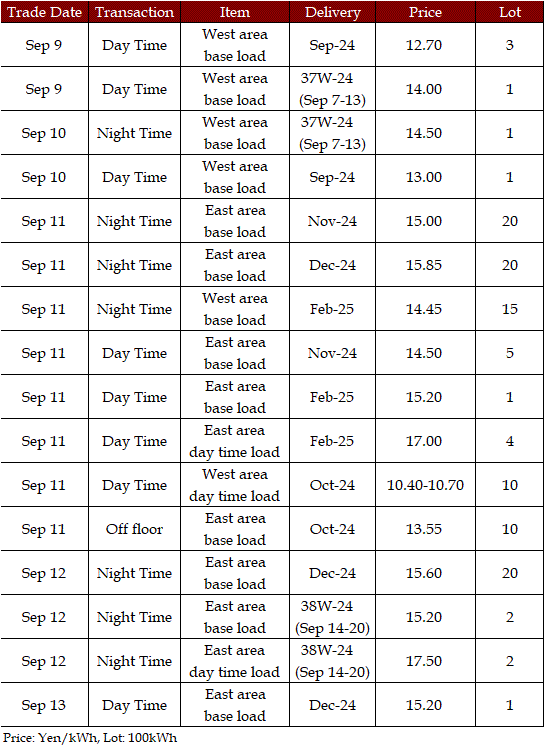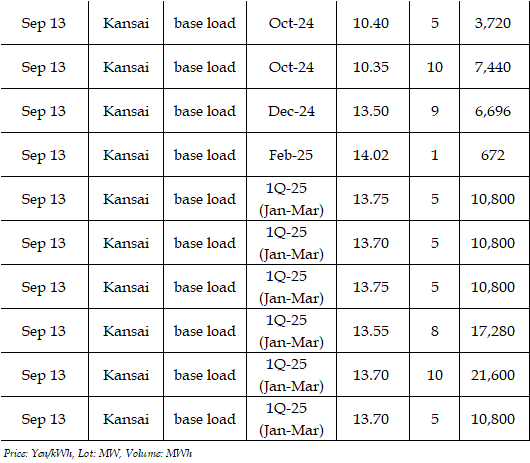|
In the day-ahead market on JEPX (Japan Electric Power Exchange), the 24-hour spot power prices on a weekly average basis for Sep 9-13 delivery bounced back from the previous week in both East Japan (50Hz) and West Japan (60Hz). The hike in spot prices came as severe post-summer heat gripped a wide range of areas in East Japan and West Japan, tightening up supply-demand fundamentals in Tokyo and Kansai.
From the middle of the week, power serve rates in evening hours in Tokyo and Kansai were estimated below 3% that would be required to maintain stable power supply. Thus, Tokyo and Kansai received emergency power supply from other areas. Reflecting the supply crunch, the imbalance fees in Tokyo sometimes jumped above Yen 100 in evening hours. The intraday market also leaped to exceed Yen 50 from time to time.
In Tokyo and Kansai, the key areas in East Japan and West Japan, the 24-hour average posted a difference in favor of the East by Yen 0.12 for Sep 9 delivery, Yen 1.14 for Sep 11 delivery, Yen 0.31 for Sep 12 delivery, and Yen 0.16 for Sep 13 delivery. Meanwhile, Kansai outperformed Tokyo by Yen 1.62 for Sep 10 delivery.
In the fuel markets, LNG and coal prices weakened from the end of the previous week. Crude oil prices were little moved.
DES Northeast Asia spot LNG prices hovered at $13 per mmBtu for prompt September 2024 arrival as of Sep 12, down about 35cts from the end of the previous week (Sep 6). The LNG market in Northeast Asia was weighed by a softness in European natural gas prices, coupled with a looming supply glut in Northeast Asia. The Ministry of Economy, Trade and Industry (METI) announced on Sep 11 that Japan's LNG inventories for power generation stood at 2.09 mil mt as of Sep 8, up 260,000mt from a week before. The level was up both from 1.64 mil mt as of end-September last year and the average of past five years at 1.99 mil mt.
FOB Newcastle thermal coal prices in Australia stood in the low $138 per ton for September 2024 loading as of Sep 12. The level was down about $3.00 from the end of the previous week, in reaction to a fall in gas and crude oil prices.
In the crude oil market, WTI crude for October 2024 stood in the low $69 level as of the morning on Sep 13 while Brent crude for November 2024 was trading in the low $72 level. Both WTI and Brent were down about $2.50 from the end of the previous week. The Organization of the Petroleum Exporting Countries (OPEC) said in its monthly report released on Sep 10 that it revised down the forecasts for global oil demand for 2024 as well as the demand expectations for 2025. The bearish outlook raised concerns over looser supply-demand fundamentals going forward, spurring sell-offs in crude futures. But the crude market later drew bargain hunting. Furthermore, as hurricane "Francine" approached the US Gulf of Mexico, concerns grew over supply disruptions at oil facilities, helping crude futures erase part of the loss earlier in the week.
The actual highest price during the week was at Yen 39.00 in six areas from Hokkaido to Hokuriku for Sep 13 delivery. Meanwhile, the actual lowest price during the week was at Yen 5.01 in Kyushu for Sep 12 delivery.
By area, the weekly average of the 24-hour spot prices was at Yen 15.96 in Hokkaido, up Yen 3.78 from the previous week, Yen 16.34 in Tohoku, up Yen 2.83, Yen 17.83 in Tokyo, up Yen 3.78, Yen 18.02 in Chubu, up Yen 4.53, Yen 17.11 in Hokuriku, Kansai, Chugoku and Shikoku, up Yen 4.64, and Yen 15.28 in Kyushu, up Yen 3.94.
In the JEPX auction, volumes of offers were 1,054.15 mil kWh on a weekly average basis, down 15.4% from the previous week. Meanwhile, bids on a weekly average basis expanded by 13.9% to 1,119.77 mil kWh. The weekly average of trade volumes grew by 3.9% to 788.99 mil kWh.
Power demand in nine areas of Japan during Sep 9-13 was a combined 14,436.90 mil kWh, up 8.9% from 13,259.56 mil kWh during Sep 2-6. The figure was up 8.1% from the corresponding period a year earlier. Demand during Sep 11-15, 2023 after day of week adjustment was 13,258.14 mil kWh.
In the JEPX forward market, no deals were confirmed during Sep 9-13.
Deals reported on TOCOM (Tokyo Commodity Exchange) during Sep 9-13 were as below.

Deals reported on EEX (European Energy Exchange) during Sep 9-13 were as below.









In the third week of September, spot prices are expected to fall from the second week. The highest temperature is forecast to reach the extremely hot day indicator of 35 degrees in some parts of West Japan until the middle of the week, but heat waves will be alleviated through the latter half of the week. In East Japan, the day's high is forecast to stay below 35 degrees throughout the week. Intense heat seen in the second week is expected to ease in both East Japan and West Japan, so that spot prices will likely soften. But an increasing number of thermal units are scheduled to halt operation for regular maintenance, a factor that will trim power reserve rates. Thus, there is still a possibility of unexpected price spikes in case of fresh troubles at generation facilities.
|
JEPX: System Price (Day Ahead 24 hours)
|
|
Weekday Price
|
9-Sep
|
10-Sep
|
11-Sep
|
12-Sep
|
13-Sep
|
|
24-Hour Ave
|
15.62
|
16.96
|
18.58
|
17.12
|
17.42
|
|
Volume (MWh)
|
784,209
|
782,226
|
800,750
|
785,485
|
792,264
|
|
(unit: yen per kWh) (date: delivery day)
|
|
|

|